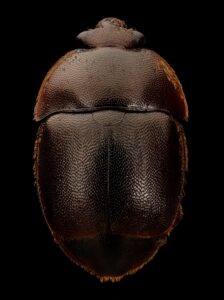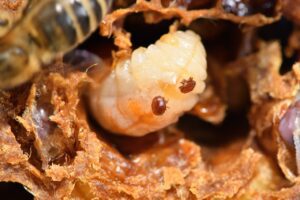Varroa mites pose a significant threat to honey bee colonies worldwide, impacting bee health and productivity. Effective management of these parasites is crucial for beekeepers striving to maintain thriving hives. In this article, we delve into 10 proven methods to control Varroa mites, covering monitoring strategies, natural treatments, and the importance of adopting integrated pest management (IPM) practices. By implementing these techniques, beekeepers can safeguard their bees against Varroa mite infestations and promote sustainable beekeeping practices.
Table of Contents

1. Monitor Varroa Mite Levels Regularly
- Why Monitoring is Important Monitoring varroa mite levels regularly is crucial for beekeepers to assess bee health and intervene promptly if mite populations become problematic. Here’s why it matters:
- Early Detection: Regular monitoring allows beekeepers to catch varroa mite infestations early, before they reach levels that can seriously harm the colony. Varroa mites weaken bees by feeding on their hemolymph (blood) and transmitting viruses, which can lead to reduced lifespan, decreased brood viability, and colony collapse.
- Effective Management: By knowing the mite levels in your hives, you can implement targeted management strategies. This might include applying treatments when mite populations exceed thresholds or taking steps to enhance hive health to mitigate mite impacts.
- Monitoring Methods: Common methods for monitoring varroa mite levels include:
- Sticky Boards: Placing sticky boards under hive bottom boards for a period (usually 24-48 hours) and then counting the mites that fall onto the boards.
- Alcohol Washes: Sampling bees and washing them in alcohol to dislodge mites, which are then counted and used to calculate mite infestation levels.
- Sugar Shakes: Dusting bees with powdered sugar and then collecting mites that fall off due to the sugar’s stickiness.
2. Use Drone Brood Removal
- How Drone Brood Removal Works Varroa mites preferentially infest drone brood (male bee larvae) because the longer development period of drones allows mites more time to reproduce. Here’s how this method can help manage mite populations:
- Interrupting Reproduction: By removing drone brood containing mite offspring, beekeepers disrupt the varroa mite reproductive cycle. This can significantly reduce mite population growth within the hive.
- Timing and Technique: Drone brood removal is most effective during periods when mite populations are expected to peak, such as in early summer. Beekeepers carefully cut out drone brood frames and replace them with foundation frames to maintain hive structure and bee population.
- Integrated Pest Management (IPM): Incorporating drone brood removal into an IPM strategy alongside other treatments and hive management practices can enhance overall mite control effectiveness.
3. Apply Oxalic Acid Treatments
- Effectiveness of Oxalic Acid Oxalic acid is a naturally occurring organic acid that has shown effectiveness against varroa mites, particularly when used during periods of low brood production. Here’s how it can be used effectively:
- Targeting Phoretic Mites: Oxalic acid primarily targets phoretic mites—those attached to adult bees—rather than those within capped brood cells. This makes it effective during times when brood levels are low, such as in late fall or winter.
- Application Methods: There are several methods for applying oxalic acid, including dribbling, vaporization, or sublimation. Each method requires careful attention to dosage and application techniques to ensure safety for bees and effectiveness against mites.
- Safety Considerations: Beekeepers must follow recommended safety guidelines and application protocols when using oxalic acid. Proper protective equipment and understanding environmental conditions (temperature, humidity) during application are critical to minimizing stress on bees.
4. Utilize Formic Acid Treatments
- Benefits of Formic Acid Formic acid is a naturally occurring substance found in some plants and has been used effectively as a treatment for varroa mites in beekeeping. Here’s how it can benefit your hives:
- Effective Mite Control: Formic acid has demonstrated effectiveness in reducing varroa mite populations while being less harmful to bees compared to some synthetic chemicals. It targets mites both on adult bees and within capped brood cells.
- Application Methods: Beekeepers can apply formic acid treatments using pads, strips, or through vaporization methods. Each application method requires careful monitoring of hive conditions, particularly temperature and humidity, to ensure safe and effective treatment.
- Integrated Pest Management (IPM): Integrating formic acid treatments into an IPM approach alongside other management practices can help reduce reliance on single treatment methods and mitigate the risk of mite resistance development.
5. Implement Thymol Treatments
- Using Thymol for Mite Control Thymol is a natural compound derived from thyme plants and has shown promise as a treatment for varroa mites in beekeeping. Here’s how beekeepers can effectively use thymol:
- Mode of Action: Thymol disrupts varroa mite reproduction by affecting their cellular metabolism and nervous system. It is particularly effective against phoretic mites on adult bees.
- Application Methods: Thymol treatments are available in various forms, including as gels or in vapor form. Beekeepers must follow manufacturer instructions for application to ensure safe and effective use.
- Environmental Considerations: Temperature and hive ventilation play crucial roles in the effectiveness of thymol treatments. Beekeepers should apply thymol during periods of mild weather and adequate hive ventilation to prevent stress on bees.
6. Employ Essential Oils
- Effectiveness of Essential Oils Essential oils such as wintergreen and tea tree oil have gained attention for their potential as natural varroa mite treatments in beekeeping. Here’s how beekeepers can utilize essential oils effectively:
- Natural Repellent Properties: Certain essential oils, like wintergreen and tea tree oil, possess natural repellent properties against varroa mites. They interfere with mite behavior and reproduction.
- Application Methods: Essential oils can be applied as solutions, incorporated into pollen patties, or used in other formulations. Beekeepers should adhere to recommended dosages and application methods to avoid harming bees.
- Safety and Compatibility: Before using essential oils, beekeepers should ensure they are safe for bees and compatible with other treatments or hive management practices in use. Consulting with experienced beekeepers or experts can provide valuable insights into effective application.
7. Practice Sugar Dusting
- How Sugar Dusting Works Sugar dusting is a non-chemical method used to dislodge varroa mites from adult bees, reducing mite populations within the hive. Here’s how beekeepers can effectively practice sugar dusting:
- Mechanism of Action: Powdered sugar is dusted onto bees, causing mites to lose their grip due to the sticky nature of sugar. Dislodged mites fall from bees and onto the hive bottom or sticky board.
- Application Frequency: Sugar dusting is typically performed at regular intervals during periods when mite populations are actively reproducing. It is less effective than chemical treatments but can be part of an integrated pest management (IPM) strategy.
- Considerations: Beekeepers should consider hive conditions, weather, and bee activity levels when sugar dusting to minimize stress on bees. Properly monitoring mite levels before and after dusting helps assess effectiveness.
8. Incorporate Screened Bottom Boards
- Benefits of Screened Bottom Boards Screened bottom boards are hive components with a mesh or screen bottom that allows mites to fall out of the hive, reducing mite populations. Here’s how they can benefit your hives:
- Mite Drop Monitoring: Screened bottom boards facilitate easy monitoring of varroa mite levels by collecting mites that naturally fall from adult bees or during grooming.
- Improved Hive Ventilation: The mesh or screen design of bottom boards enhances hive ventilation, which is crucial for maintaining optimal hive conditions and reducing moisture levels.
- Maintenance and Management: Beekeepers should regularly clean and maintain screened bottom boards to ensure they remain effective. Removing debris and monitoring mite drop rates helps assess mite population trends.
9. Use Varroa Mite Resistant Bee Strains
- Choosing Resistant Bee Strains Some bee strains exhibit natural resistance or tolerance to varroa mites, which can help reduce the need for intensive chemical treatments. The USDA has more information here. Here’s how beekeepers can incorporate resistant bee strains into their management practices:
- Genetic Resistance: Resistant bee strains have genetic traits that enable them to detect and remove mites through grooming behavior or other natural mechanisms.
- Breed Selection: Beekeepers can selectively breed or purchase queens from bee breeders known for breeding varroa-resistant strains. This approach supports sustainable hive management and reduces reliance on chemical treatments.
- Monitoring and Support: While resistant bee strains offer advantages, beekeepers should still monitor mite levels and hive health regularly. Integrated pest management (IPM) practices can help maintain effective mite control over time.
10. Rotate Treatments to Prevent Resistance
- Importance of Treatment Rotation Varroa mites can develop resistance to specific treatments over time, reducing their effectiveness. Implementing treatment rotation strategies helps mitigate resistance development and maintain effective mite control. Here’s why it’s crucial:
- Reduced Resistance Risk: Rotating treatments with different modes of action reduces the likelihood of varroa mites developing resistance to specific chemicals or methods.
- Integrated Approach: Integrated pest management (IPM) strategies recommend rotating treatments alongside other management practices, such as hive hygiene and genetic diversity.
- Consultation and Monitoring: Beekeepers should consult with local experts or beekeeping associations to develop tailored treatment rotation schedules based on local conditions and mite resistance patterns. Regular monitoring of mite levels and treatment efficacy informs adjustments to rotation strategies.
Conclusion
Effective management of Varroa mites is essential for maintaining healthy honey bee colonies and ensuring their long-term productivity. By incorporating these 10 strategies into your beekeeping practices—from regular monitoring and natural treatments to strategic hive management and treatment rotation—you can mitigate the impact of Varroa mites and support sustainable beekeeping. Protecting bees from Varroa mite infestations not only preserves their health but also contributes to pollination efforts and ecosystem balance. Embrace these methods to safeguard your bees and foster thriving hive environments. Click here for more information on 8 Common Beehive Pests and Effective Prevention Tips for Beekeepers.



